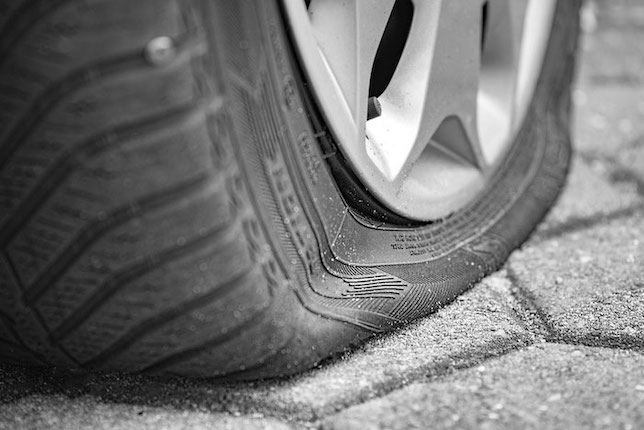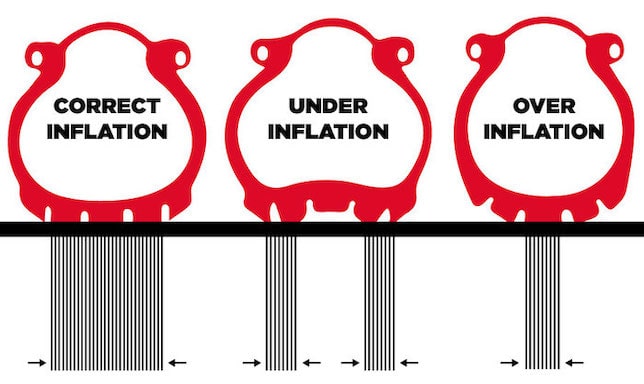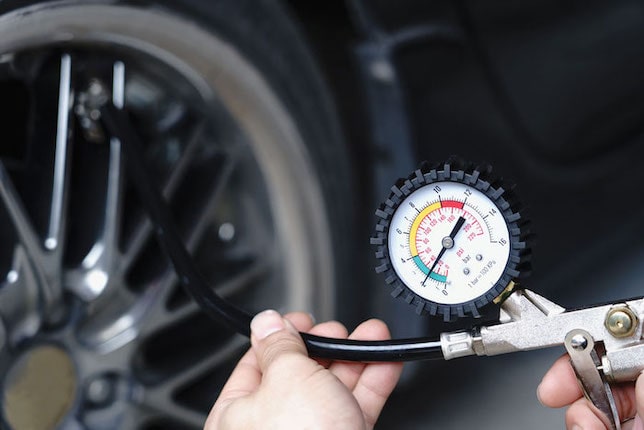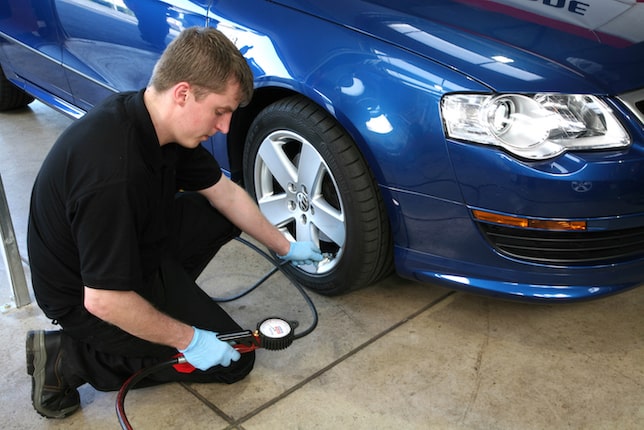Check your
recommended
tyre pressures
Enter your registration
number below
TYRE PRESSURES: Tyre Pressure Check Online & Search by Reg
Why should tyre pressures be checked?
Your tyres are key to staying safe on the roads and worn or dangerous tyres risk lives. You should regularly check your tyre pressure (at least once a month) as well as before any long journeys to stay safer on the road. Plus, the right tyre pressure can extend the life of your tyres.

Under-inflated tyres
Under-inflated tyres affect road handling, making it harder to steer round corners. Your tyres are also more likely to overheat, which increases the risk of a blowout and being involved in a tyre-related accident.
Did you know that dangerous tyres lead to around 5,000 convictions, 900 casualties, and 160 deaths or serious injuries every year?
Under-inflated tyres usually cause rapid wear on the outside edges and your tyres may become illegal, they also affect braking performance and increase your fuel consumption, so doing simple checks will not only keep you safe, but also save you money.
Why tyre pressure can drop
Over-inflated tyres
Over-inflated tyres can cause the sidewalls and tread to become harder, resulting in reduced traction and an uncomfortable ride. That increases the risk of a tyre blowout and a potential accident.
Over-inflated tyres will cause rapid wear in the centre of the tyre, as reduced traction puts more pressure on the centre of the tyre. The decrease in contact with the road causes the engine to work harder, increases fuel consumption and may affect braking performance, so doing simple checks will not only keep you safe, but also save you money.

Are under-inflated tyres illegal?
Not necessarily, but under-inflated tyres tend to cause uneven tyre wear and could mean that the full width of your tyre tread may not be legal. Also, if the TPMS warning light is lit, you’ll need to check your tyre pressures as soon as possible to stay safe and keep your tyres in good condition for longer. It’s worth noting that warning lights may cause your vehicle to fail its MOT.
Are over-inflated tyres illegal?
Again, not necessarily, but over-inflated tyres tend to cause uneven tyre wear, especially to the centre of the tyre, and could mean that the full width of your tyre tread may not be legal.
How to check tyre pressure?
Tyre pressures can be found in your vehicle's handbook, are usually stamped in the sill of the driver's door and can sometimes be found inside your fuel cap. There will be different settings for fully loaded vehicles, so please remember to check these, especially if carrying extra passengers or any additional weight, i.e. luggage. These should be checked using a tyre pressure gauge (which we strongly recommend that you buy) or at a local petrol station. You can also bring your car along to any National Tyres and Autocare branch and we'll check and adjust them FREE of charge.
If you're having difficulty locating your tyre pressures, you can check your recommended tyre pressures by entering your registration number into the search box above.

What pressure should car tyres be?
Tyre pressures vary from vehicle to vehicle. The vehicle manufacturers determine the correct pressures for each make and model. Tyre pressures are measured in PSI which is the pounds per square inch.
What PSI should my tyres be?
The correct tyre pressures for your car can be found in your vehicle's handbook, driver's door sill or sometimes inside your fuel cap. If you can't find the correct tyre pressures for your vehicle, please use our tyre pressure lookup system above or call in to one of our branches for a FREE check.
When should the tyre pressure monitoring system be set?
Modern cars are fitted with a tyre pressure monitoring system (TPMS), which will alert you if the tyre pressure increases or decreases. The pressure levels for the TPMS should be set when the tyres are cold and aren’t under a heavy load. Therefore, an ideal scenario for the system to be set is on a flat surface with only the driver in the car, before a journey is started.
Can I drive with the tyre pressure warning light on?
Once the warning light appears, you should pull over as soon as it is safe to do so. You can then check your tyre pressures externally, to see if any tyres are underinflated or have a puncture. Under-inflated tyres will wear faster and give you less control of the car whilst driving. Therefore, it’s vital to check your tyres if the warning light comes on.
If the car is under heavy load, then the warning light may appear. This is due to the pressures slightly changing due to the increased weight load. However, you should still check your tyres before starting or continuing your journey.
Are tyre pressures checked in an MOT?
Tyre pressures are not checked in a vehicle's MOT, but if you have a faulty TPMS (tyre pressure monitoring system) this will fail the MOT.

How to find tyre pressures for different cars?
If you’re looking for a Ford Fiesta’s tyre pressure or BMW tyre pressure, you can find the PSI in the car’s handbook. The handbook will detail the specific tyre pressure for your make and model. Another way of finding tyre pressure is by looking for the tyre sticker, which can either be found on the inside of the fuel cover or the side of the passenger door. This can be used to find the Mercedes tyre pressure, VW tyre pressure, Fiat tyre pressure or any other car's tyre pressure.
Tyre Pressures by Vehicle
At National, using our Tyre Pressures lookup, we can find out the specific tyre pressure needed for your tyres specific to your manufacturer. Our tyre pressure lookup can find the tyre pressures for the below vehicles, and many other car manufacturers. All you need to do is enter your vehicle registration number into the tyre pressure lookup on this page. Please note, the buttons below will take you back up to the top of this page. From here, please enter your vehicle registration to find tyre pressures for your vehicle online.
Audi Tyre Pressure - Audi Tyre Pressures for your car
Audi Tyre Pressures
BMW Tyre Pressure - BMW Tyre Pressures for your car
BMW Tyre Pressures
Citroen Tyre Pressure - Citroen Tyre Pressures for your car
Citroen Tyre Pressures
Fiat Tyre Pressure - Fiat Tyre Pressures for your car
Fiat Tyre Pressures
Ford Tyre Pressure - Ford Tyre Pressures for your car
Ford Tyre Pressures
Hyundai Tyre Pressure - Hyundai Tyre Pressures for your car
Hyundai Tyre Pressures
Jaguar Tyre Pressure - Jaguar Tyre Pressures for your car
Jaguar Tyre Pressures
Kia Tyre Pressure - Kia Tyre Pressures for your car
Kia Tyre Pressures
Mercedes Tyre Pressure - MercedesTyre Pressures for your car
Mercedes Tyre Pressures
Nissan Tyre Pressure - Nissan Tyre Pressures for your car
Nissan Tyre Pressures
Peugeot Tyre Pressure - Peugeot Tyre Pressures for your car
Peugeot Tyre Pressures
Renault Tyre Pressure - Renault Tyre Pressures for your car
Renault Tyre Pressures
Seat Tyre Pressure - Seat Tyre Pressures for your car
Seat Tyre Pressures
Skoda Tyre Pressure - Skoda Tyre Pressures for your car
Skoda Tyre Pressures
Tesla Tyre Pressure - Tesla Tyre Pressures for your car
Tesla Tyre Pressures
Vauxhall Tyre Pressure - Vauxhall Tyre Pressures for your car
Vauxhall Tyre Pressures
Volkswagen Tyre Pressure - Volkswagen Tyre Pressures for your car
VW Tyre Pressures
How much air to put in the tyres?
By using the information above to find the correct tyre pressure for the model of your vehicle, you can use the gauge on a pump to inflate your tyre to the correct level of PSI. Be careful to not under or over-inflate the tyre, as this can lead to excessive wear on the tyre.


 Sign up for SPECIAL OFFERS
Sign up for SPECIAL OFFERS
